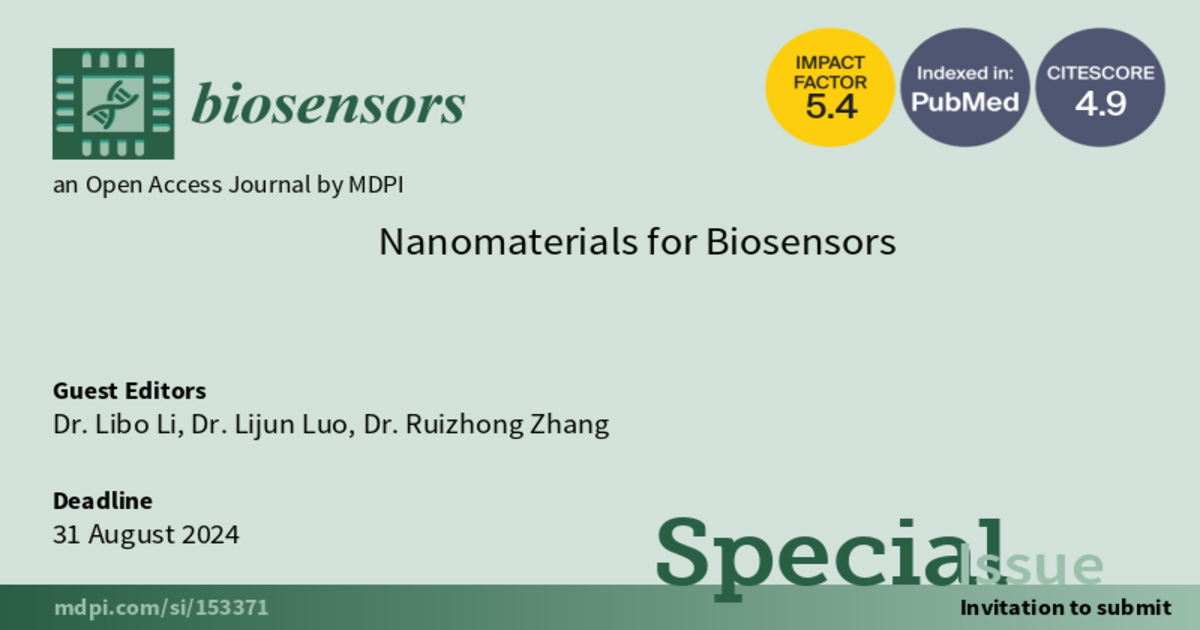Nanomaterials for Biosensors
A special issue of Biosensors (ISSN 2079-6374). This special issue belongs to the section "Biosensor Materials".
Deadline for manuscript submissions: closed (31 August 2024) | Viewed by 9817

Special Issue Editors
Interests: nanomaterials; electrochemistry; electrochemiluminescence; fluorescent sensing
Interests: aptasensor; nanomaterials; electrochemistry; electrochemiluminescence
Special Issue Information
Dear Colleagues,
Biosensors are a type of analytical device that are applied to detect chemical and biological substances by converting their concentration into electrical signals for output. Biosensors consist of biological recognition components including DNA, RNA, antibodies, enzymes, cells, aptamers, and physicochemical transducers such as electrical, optical, chemical, physical detectors. Due to their high sensitivity, good selectivity, and fast analysis speed, biosensors have been widely applied in various sectors of the national economy such as food quality, pharmaceutical, chemical, clinical laboratory, biomedicine, environmental monitoring, and so on. In recent years, the rapid development of nanotechnology has provided a rare opportunity for the fabrication of new biosensors. Nano-biosensors are the fusion of nanotechnology and biosensors, which have become a significant research hotspot. However, the new nano-biosensors also face many challenges, such as sensitivity, specificity, biocompatibility, integration of multiple technologies, simplified detection methods, preparation processes, cost-effectiveness, etc.
This Special Issue of Biosensors aims to supply a platform for publishing original high-quality research papers and comprehensive reviews related to the design and synthesis of any nanomaterials and their application in biosensors. Any type of experimental and theoretical research about biosensors in nanotechnology is welome.
Dr. Libo Li
Dr. Lijun Luo
Dr. Ruizhong Zhang
Guest Editors
Manuscript Submission Information
Manuscripts should be submitted online at www.mdpi.com by registering and logging in to this website. Once you are registered, click here to go to the submission form. Manuscripts can be submitted until the deadline. All submissions that pass pre-check are peer-reviewed. Accepted papers will be published continuously in the journal (as soon as accepted) and will be listed together on the special issue website. Research articles, review articles as well as short communications are invited. For planned papers, a title and short abstract (about 100 words) can be sent to the Editorial Office for announcement on this website.
Submitted manuscripts should not have been published previously, nor be under consideration for publication elsewhere (except conference proceedings papers). All manuscripts are thoroughly refereed through a single-blind peer-review process. A guide for authors and other relevant information for submission of manuscripts is available on the Instructions for Authors page. Biosensors is an international peer-reviewed open access monthly journal published by MDPI.
Please visit the Instructions for Authors page before submitting a manuscript. The Article Processing Charge (APC) for publication in this open access journal is 2700 CHF (Swiss Francs). Submitted papers should be well formatted and use good English. Authors may use MDPI's English editing service prior to publication or during author revisions.
Keywords
- nanotechnology
- nanomaterials
- biosensors
- optical sensors
- electrochemical sensors
- electrochemiluminescence sensors
- photoelectrochemical sensor
- sensitivity and selectivity
- environmental monitoring
Benefits of Publishing in a Special Issue
- Ease of navigation: Grouping papers by topic helps scholars navigate broad scope journals more efficiently.
- Greater discoverability: Special Issues support the reach and impact of scientific research. Articles in Special Issues are more discoverable and cited more frequently.
- Expansion of research network: Special Issues facilitate connections among authors, fostering scientific collaborations.
- External promotion: Articles in Special Issues are often promoted through the journal's social media, increasing their visibility.
- e-Book format: Special Issues with more than 10 articles can be published as dedicated e-books, ensuring wide and rapid dissemination.
Further information on MDPI's Special Issue polices can be found here.






